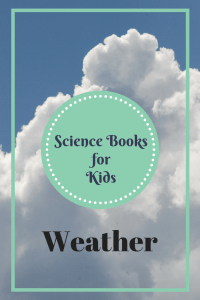Our post today was inspired by Clouds: A Compare and Contrast Book by Katharine Hall.
Young readers explore the concept of comparing and contrasting, while at the same time learning about different kinds of clouds and how to describe them.
Some clouds are big and fluffy;
others are thin and wispy.
The simple picture book book is illustrated with a series of two-page spreads filled with gorgeous color photographs of different types of clouds, like the one on the cover.
The real treasure, however, is the “For Creative Minds” in the back matter. This section has four pages of interactive activities to reinforce learning. Examples include experiments with evaporation, a cloud match exercise, and information about how clouds are connected to weather prediction.
Because evaporation is the source of water that ends up in clouds, let’s try some evaporation experiments of our own.
Water Evaporation
Evaporation is a chemical process that involves a change of state from liquid to gas.
1. Observation opportunity for youngest scientists
To study evaporation, you will need water, sponges or paint brushes, and a sidewalk or other flat surface on a sunny, hot day. Simply paint the water onto a flat surface and watch it evaporate. Try different surfaces, different amounts of water, different patterns of application, etc. Use sidewalk chalk to draw around a large wet patch and then revisit the site to emphasize how the wet area has been reduced over time.
If the children ask, explain that the liquid water is turning into a gas or vapor as it disappears and is rising up into the air.
2. Simple evaporation experiment for young scientists
Can you prevent evaporation with plastic wrap?
Gather:
- Water
- Measuring cup
- Plastic wrap
- Timing device (optional)
- Level, flat, hard surface like sidewalk or driveway
- Rocks to hold down plastic wrap (optional)
Create two similar-sized and similar-shaped wet areas by pouring a measured amount of water onto a flat, level surface (1/4 cup of water works well). Note:Â If the surface is sloped, the water will tend to roll off and form irregular shapes.
Cover one of the spots with plastic wrap and hold down with rocks, if necessary.
 Wait a few minutes (time will vary with temperature, sunlight, and humidity).
Wait a few minutes (time will vary with temperature, sunlight, and humidity).
Return and assess which spot has evaporated the most.
3. Evaporation challenge for middle-grade scientists
Gather:
- Shallow plates or bowls
- Bottles or jars, preferably with narrow necks
- Measuring cup(s)
- Timing device(s)
- Thermometer(s)
- Cotton balls or tissues
- Markers
- Paper
- Scales to weigh bowls and jars
Challenge the children to come up with questions about evaporation and then generate a hypothesis. Using the materials provided, design and carry out an experiment to test their hypothesis.
Some suggestions:
- Measure the rate of evaporation of 1/4 cup of water in a shallow plate or bowl versus in a narrow-necked jar (For example:Â weigh the bowls and jars with water before and after evaporation).
- Measure the rate of evaporation in a shallow dish in the sun versus in a shady location (mark the levels before and after evaporation with a marker).
- Measure the rate of evaporation of 1/4 cup of water open in a shallow dish versus 1/4 cup of water soaked into tissue or cotton balls in a shallow dish.
- Take the temperature with the thermometer on a sunny surface. Then place a wet tissue or cotton ball over the base of the thermometer. How does the temperature change over time?
Discuss their results.
Older engineers will likely enjoy the evaporation-powered engine we discussed in the STEAM festival post about engineering.
 Further resources:
The book publisher, Arbordale Publishing, offers a number of resources, including a free 17 page Teaching Activities Guide to accompany Clouds (see right sidebar).
 We have a growing list of weather-related children’s books at Science Books for Kids.
We have a growing list of weather-related children’s books at Science Books for Kids.
Children interested in weather? They might enjoy this wind map of the U.S. How would the amount of wind effect evaporation?
___________________________
Disclosures: The book was from our local library. Also, I am an affiliate for Amazon. If you click through the linked titles or ads and make a purchase, I will receive a small commission at no extra charge to you. Proceeds will be used to maintain this self-hosted blog.
Come visit the STEM Friday blog each week to find more great Science, Technology, Engineering and Math books.




0 Comments
1 Pingback